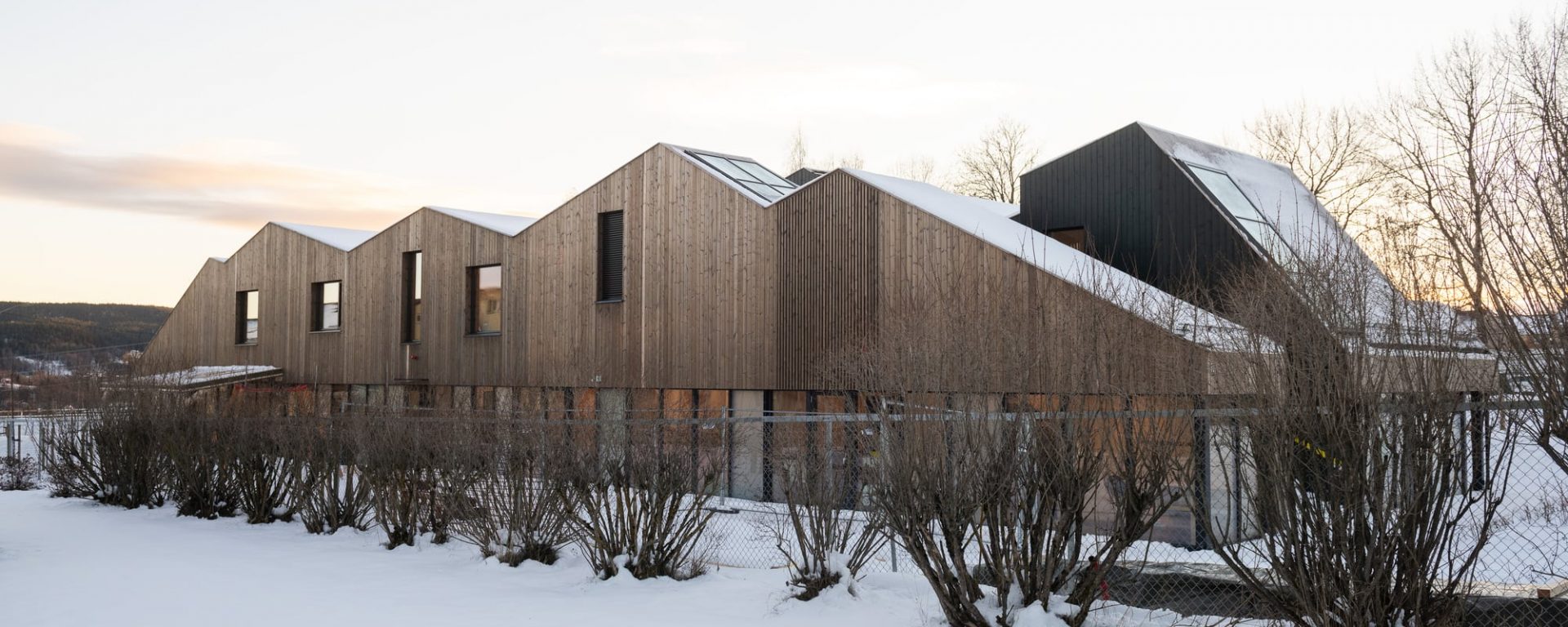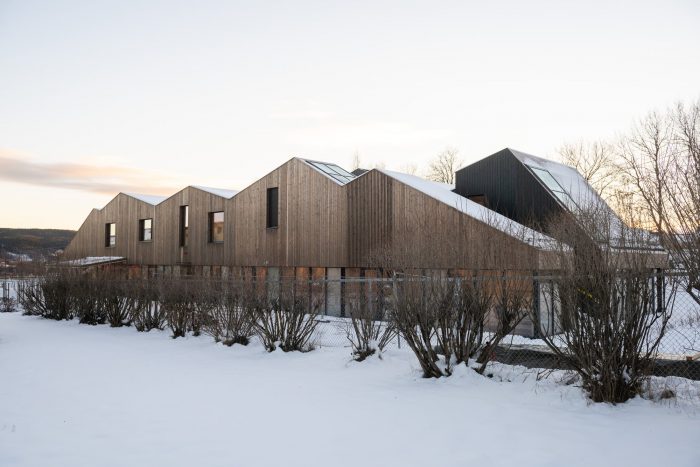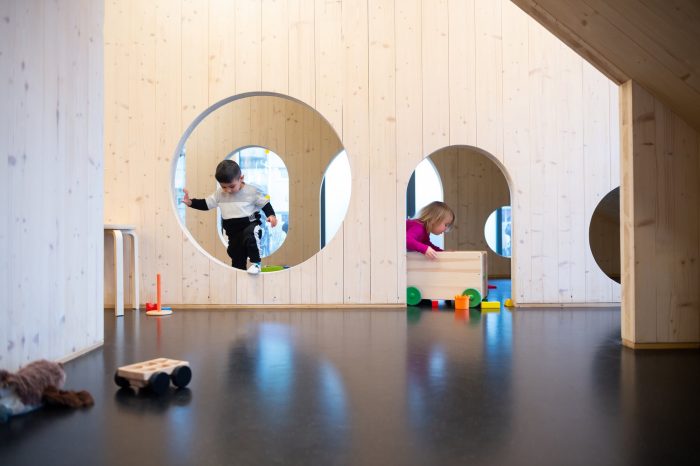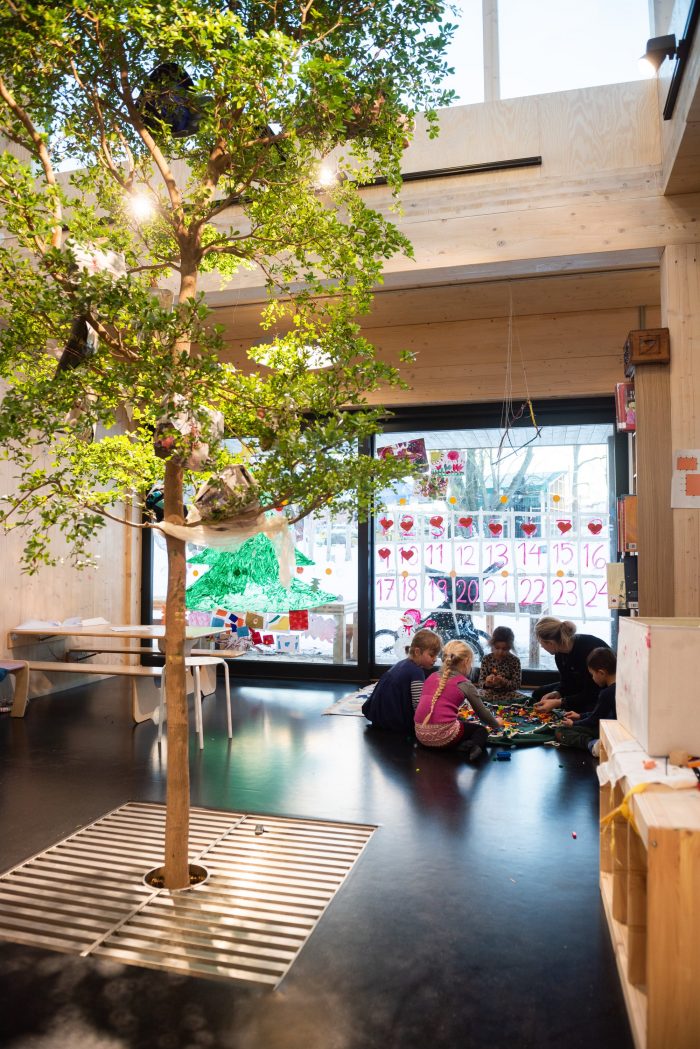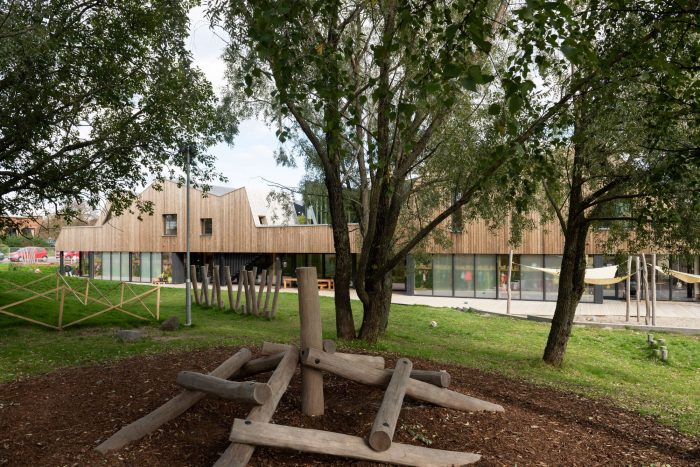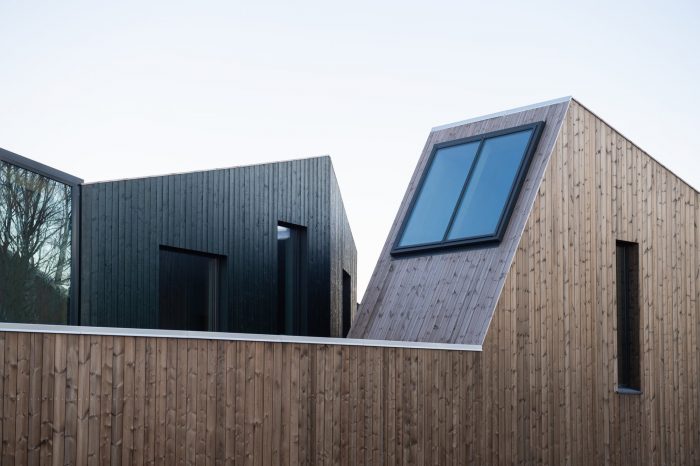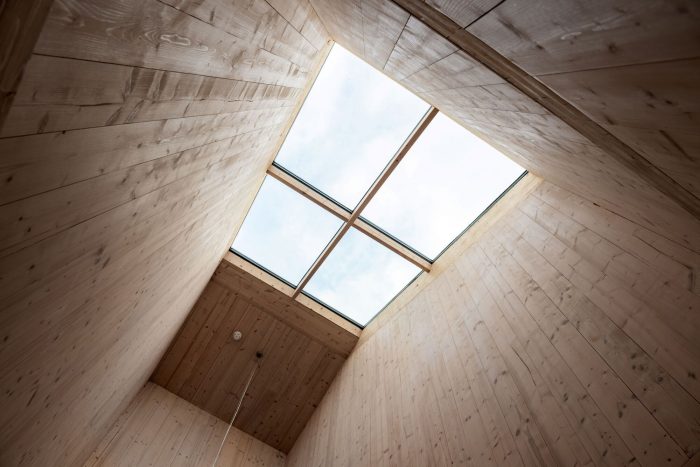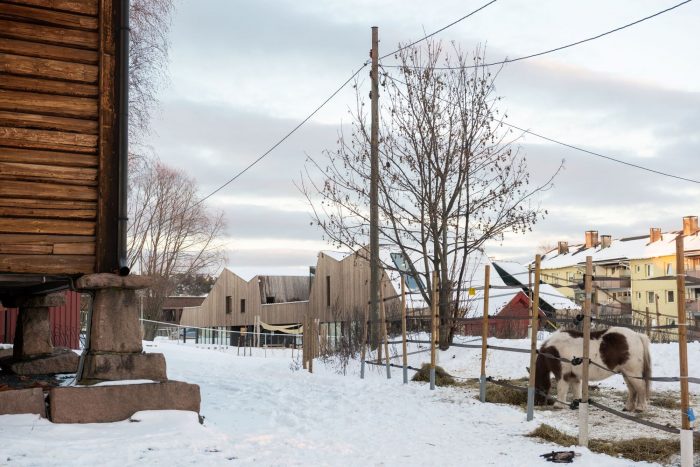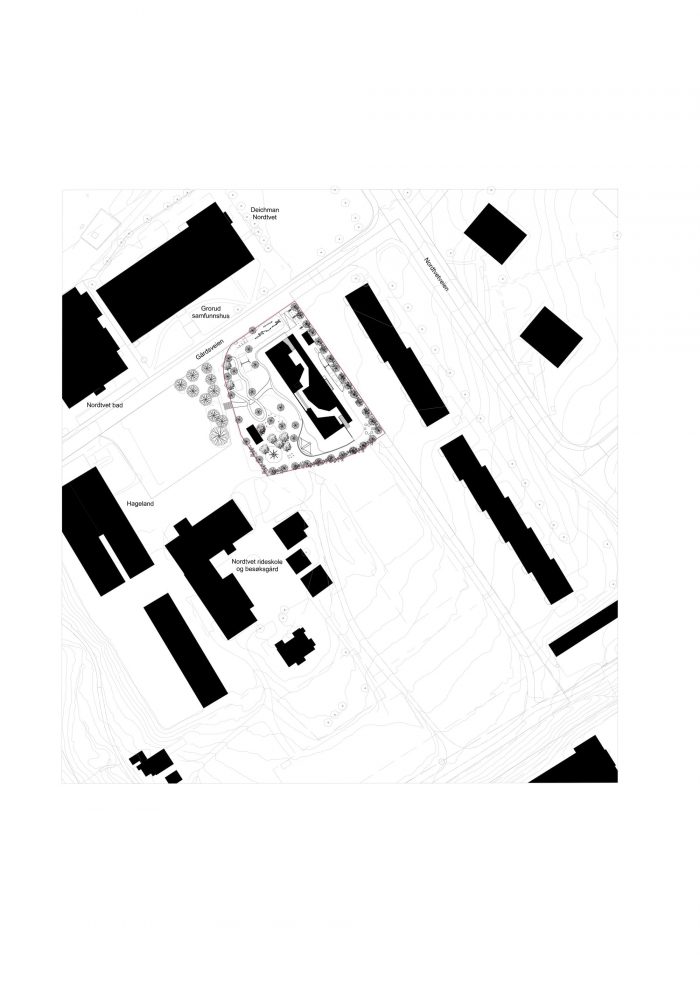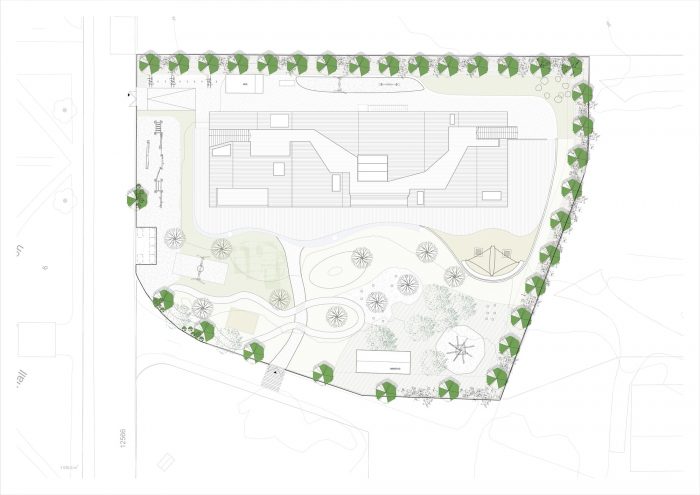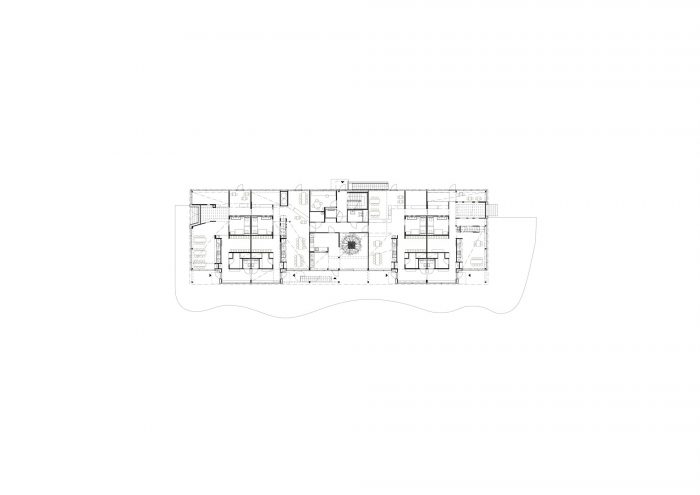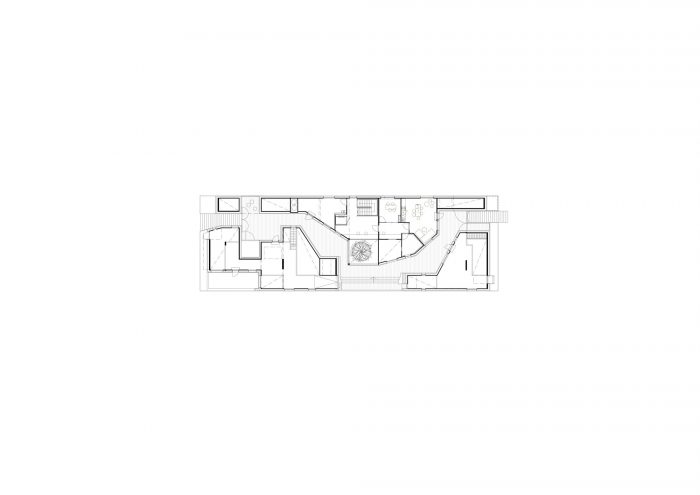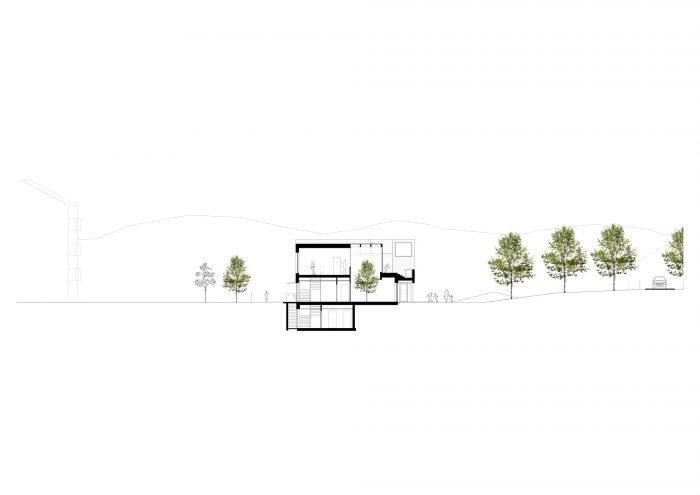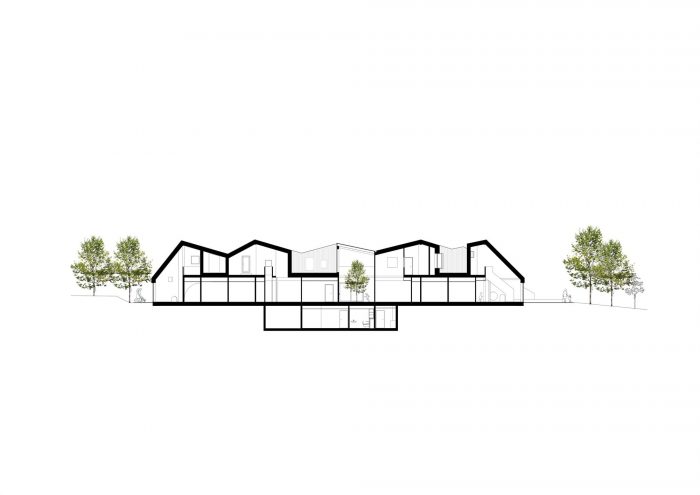位置。Nordtvet农场幼儿园位于奥斯陆东北部的Kalbakken区。幼儿园与一个向公众开放的农场为邻,并与之互动。农场有一个骑马场,一个农庄,以及可以参观的动物。在附近,还有一个公共游泳池和图书馆,以及公寓楼。
Location. Nordtvet Farm Kindergarten is located in northeastern Oslo, in the district of Kalbakken. The kindergarten is neighbor to, and interacts with, a farm that is open to the general public. The farm has a horseback-riding field, a farmyard, and animals one can visit. In the immediate vicinity, there is also a public swimming pool and library, and apartment buildings.
作为第三位老师的建筑。教育研究表明,儿童的学习和发展过程是在与其他儿童、教师和物理环境的互动中进行的。因此,根据教育学家雷吉奥-艾米利亚的方法,幼儿园可以被看作是 “第三位老师”。因此,在设计过程中,形式、光线、颜色、材料、气味、声音和微气候都是重要的参数。儿童的观点一直是最重要的。我们希望吸引儿童的想象力和对世界的理解,并设计一所建筑本身就是导师的幼儿园。幼儿园保证了孩子们的安全环境。同时,幼儿园通过空间背景促进游戏、学习和身体活动,在这里,光和影,以及房间大小、声音和气味的变化创造了非同寻常的地方。该建筑挑战了儿童的运动技能以及他们的幻想能力。
The building as the third teacher. Educational research shows that children’s learning and development processes occur in interaction with other children, teachers, and the physical environment. The kindergarten can thus be seen as a ‘third teacher’ according to the pedagogue Reggio Emilia approach. Form, light, colors, materials, smells, sounds, and microclimate have therefore been important parameters during the design process. The children’s perspective has been paramount. We wanted to appeal to children’s imagination and understanding of the world and design a kindergarten where the building itself is a mentor. The kindergarten ensures a safe environment for the children. At the same time, the kindergarten facilitates play, learning, and physical activity through spatial contexts where light and shadow, and variation in room sizes, sounds, and smells create extraordinary places. The building challenges the children’s motoric skills as well as their ability to fantasize.
适应场所。幼儿园通过具有农场般的特点来适应周围的环境。建筑的表现形式是一个在柱子上竖起的木质体,这可以让人联想到挪威传统的 “stabbur”(挪威农场的传统粮仓)。 但与 “stabbur “不同的是,底层的房间是用玻璃封闭的。这确保了室内的明亮和透明,并能看到外部游戏区、农场和动物的景色。幼儿园的第二层是一个连续的木制屋顶。屋顶体量被分割成一系列的坡屋顶,有助于与农场建筑的建筑学关系。颇为规则的底层平面和不规则的木质屋顶之间的交汇,在内部形成了一系列不同的房间和一个非常多样化的部分。一条小路穿过屋顶,形成了一系列大大小小的户外空间。这些空间为儿童停留和玩耍的区域提供了便利。因此,屋顶区域成为幼儿园游戏区的一部分。
Adaptation to place. The kindergarten adapts to the surroundings by having a farm-like character. The architectonic expression is a wooden volume raised on columns, which can give associations to a traditional Norwegian ‘stabbur’ (the traditional Norwegian granary on farms). Unlike the ‘stabbur’ though, rooms on the ground floor are enclosed with glass. This ensures bright and transparent interiors and views toward exterior play areas, the farm, and its animals. The second floor of the kindergarten is a continuous wooden roof. The roof volume is broken up into a series of gabled rooves that contribute to an architectonic relation with the farm buildings. The meeting between the quite regular ground floor plan, and the irregular wooden roof, form a series of different rooms inside and a very varied section. A pathway traverses the roof and forms a series of small and large outdoor spaces. These spaces facilitate areas for children to stay and play. The roof area thus becomes a part of the kindergarten’s play areas.
可持续的木制建筑。幼儿园使用交叉层压木材(CLT)的大量木材建造。基于三维的预切割制造,使具有复杂几何形状和不同房间顺序的建筑的实现变得容易。承重结构和内墙是用CLT建造的。一楼的连续玻璃幕墙使幼儿园具有透明的特点,并在内部和外部之间创造了良好的视觉接触。
Sustainable wooden building. The kindergarten is constructed in massive wood using cross-laminated timber (CLT). 3D-based pre-cut fabrication has eased the realization of a building with complex geometry and varied room sequence. The load-bearing construction and interior walls are built using CLT. The continuous glass façade on the first floor gives the kindergarten a transparent character and creates good visual contact between the interior and exterior.
在某些区域使用了半透明玻璃的窗户,以确保隐私并限制不必要的太阳热能摄入。所有的外墙都采用了挪威矿石松作为包覆材料。日光和被动式太阳能加热得到了很好的利用。大面积的窗户减少了白天对人工照明的需求,太阳的热量被吸收并储存在混凝土地板和CLT墙体中,减少了整体的能源消耗。幼儿园与奥斯陆的市政供暖系统相连。该建筑具有高效的面积使用,同时由于天花板高度的巨大变化和大面积窗户的广泛使用,给人以宽敞的感觉。
Windows with translucent glass are used in certain areas to ensure privacy and limit unwanted solar heat gain. Norwegian Ore-pine is used to clad all external walls. Daylight and passive solar heating are well utilized. Large window surfaces reduce the need for artificial lighting during the day, and warmth from the sun is absorbed and stored in the concrete floors and CLT walls, reducing the overall energy consumption. The kindergarten is connected to Oslo’s municipal heating system. The building has efficient area usage and is at the same time experienced as spacious due to the great variation in ceiling height and extensive use of large window surfaces.
室内。除了潮湿地区的几面墙和地下室的墙之外,室内表面是交叉层压的木材。这使得幼儿园很坚固,具有良好的内部气候和氛围。裸露的实木给幼儿园带来了宜人的室内气候,同时创造了一种温暖和家庭般的感觉。新的研究表明,在木制建筑中,儿童的心率比较低。此外,木材很结实,可以承受钉子、蜡笔和机械压力,同时可以有尊严地老化。
Interior. Interior surfaces are cross-laminated timber apart from a few walls in wet areas and walls in the basement. This makes the kindergarten robust, with a good interior climate and atmosphere. Exposed solid wood gives the nursery a pleasant indoor climate while creating a warm and homely feel. New research shows that children’s heart rate is lower in wooden buildings. Furthermore, wood is sturdy and can withstand nails, crayons, and mechanical stress, while aging with dignity.
外观。室外区域被赋予了自然特征。现有的植被被保留下来,所有的表面,包括小路和操场表面,都使用了草、树皮和碎石等天然材料。外部没有塑料和沥青。室外区域被组织和细分为不同的区域,以便不同的活动可以同时进行,包括儿童可以在成人不注意的情况下体验游戏的藏身之处,以及种植食物和照顾动物的地方,如鸡和兔子。社会互动。幼儿园的户外区域在幼儿园开放时间之外向公众开放。设计和可用性确保了幼儿园作为一个受欢迎的城市公共空间发挥作用,它已成为附近地区一个受欢迎的社交聚会场所。同时,当地社区的居民也感受到了同伴的所有权,并为照顾好这个地方做出了贡献。
Exterior. Outdoor areas have been given a natural character. Existing vegetation is retained and natural materials like grass, bark, and gravel are used on all surfaces, including pathways and playground surfaces. The exterior is free of both plastic and asphalt. Outdoor areas are organized and subdivided into zones so that different activities can take place simultaneously, including hiding places where children can have an experience of play unobserved by adults, and places to cultivate food and tend to animals such as chickens and rabbits. Social interaction. The kindergarten’s outdoor areas are open to the public outside of the kindergarten’s opening hours. The design and availability have ensured that the kindergarten works as a popular public urban space, and it has become a popular social meeting place in the neighborhood. At the same time residents of the local neighborhood sense fellow ownership and contribute to taking good care of the place.
Architects: MORFEUS arkitekter
Area : 1200 m²
Year : 2019
Photographs :Finn Ståle Felberg
Manufacturers : Ikea, Artigo, Fibo Trespo AS, Husmont, Sagstuen balkong og fasadeentreprenør AS, Svenneby sag AS, Uldal Vinduer
Wooden Structure Engineer : OsloTre AS
Structure Engineers : WSP Engineering
Contractors : Tømrermester Jo Morten Hagen
Design Team : Cecilie Wille, Caroline Støvring, Olav Lunde Arneberg, Mari Høstmølingen Grennæs
Landscape Architects : Studio HP Hettie Pisters, MORFEUS arkitekter, Holo Design
City : Oslo
Country : Norway

